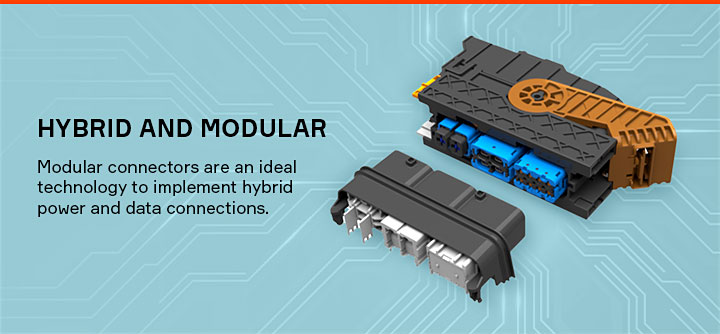Hybrid Connectors Bring Together Power and Data
Today’s vehicles are more capable than ever, offering drivers and passengers high levels of comfort, convenience and safety. But those modern features that consumers have come to rely on all require sensors, lights, actuators, displays and many other peripherals — and every piece of I/O in the vehicle must have both a power connection and a signal or data connection. As a result, vehicles have extremely complex body wiring harnesses with up to 600 connectors, each of which has to be mated correctly during assembly.
Reducing the complexity of the connections throughout the vehicle is a high priority for OEMs. One technique for achieving that is to combine power, data and signal lines into a single hybrid connector. By reducing complexity, hybrid connectors can help optimize the installation of wiring harnesses throughout a vehicle. This consolidation can be achieved for a wide variety of connection types, including coaxial and differential. For example, Aptiv’s H-MTD® differential connection systems support hybrid applications, with frequencies up to 20 GHz and data transmission rates up to 56G bit/sec.
In addition to reducing complexity, hybrid connectors reduce size: The packaging for a hybrid connector is 30 percent to 40 percent smaller than it would be with separate connectors.

Modular advantage
Early hybrid connectors brought together power and signal for a single device. Today, as connections become more numerous and therefore more dense, hybrid connectors are often part of a larger modular connector strategy.
Modular connectors have standard sizes and shapes but can accommodate multiple different interfaces. A modular connector can be a hybrid connector that terminates power, signal and data lines.
Each module can be grouped with other modules — as many as eight all together — within a standard housing that stabilizes and balances the connection to a header. The header could be on a zone controller that manages the power delivery and communications with all I/Os within a specific area of a vehicle.
One primary benefit of modularizing hybrid connectors is automation. Modules are designed for auto-plugging during harness assembly, which reduces the risk of wire damage during plugging. This in turn enables wire gauge reductions, which means less mass and cost. Plus, the standard shapes and sizes are easy for robots to grasp and assemble.
As the industry moves toward the software-defined vehicle, having the right connection systems in place to support all of the underlying hardware in the most cost- and space-efficient way will become critical. Hybrid connectors, along with modular connectors, are a logical step toward that goal.
H-MTD is a registered trademark of Rosenberger Hochfrequenztechnik GmbH & Co. KG.